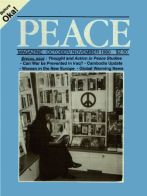
Peace Magazine Oct-Nov 1990, page 7. Some rights reserved.
Search for other articles by John Bacher here
CANADIANS have been fascinated this summer by television images of the formerly neglected Mohawk communities of Kahnawake and Kanesatake. Atragic loss of human life occuired there in a battle that was waged to block the expansion of a golf course into a sacred Indian pine forest. We witnessed gripping incidents, such as yelling clan mothers pulling back armed warnors. But behind these dramas lies an even more vivid saga-the growth, over the past 18 years, of the Warriors' Society among the 50,000 Iroquois of the continent.
The Mohawk Warriors' Society began in 1972 in Kahnawake, an Indian enclave in the Montreal urban area. Its first major action, a year later, was an attempt to expel the non-native residents of this community. This was frustrated by the decision of the band council to call in the Quebec provincial p0lice. Thereafter, the Warriors decided 10 avoid such conflict among their own people in the future by founding in 1974 a new community in New York state named Ganinkeh. Selected for its advantage in armed defence, Ganinkeh's original location in Moss Park proved unsuitable for traditional agriculture. Similar difficulties plagued Ganinkeh after it was relocated as a result of an agreement with Mario Cuomo, who was then the Secretary of State of New York. This caused its economy to become dependent on high stakes bingo and smuggling. The limited success of Ganinkeh led many Warriors to retum to Kahitawake, where they developed an increasingly dominant political in-fluence through a contraband cigarette trade organized by the Mohawk Nation Office.
A key route for cigarettes to move from the low-taxed United States to high-taxed Canadawas through another Mohawk settlement, Akwesasne. This politically complex communitv is divided into two governments by the international border between Canada and the United States. Since the Raquette Point incident in 1981, when the Mohawk Tribal Police Force was disbanded south of the border, the American side oF Akwesasne has become a haven for a variety of illegal enterprises operating in defiance of both Mohawk and American law. Mohawk governments, including the traditional council, based on an ancient clan system and affiliated to the Iroquois Confederacy, have made majoradvances in environmental protection programs and education in the Mohawk language. However, such gains have been countered by an increasing wave of organized crime. After-hour sales of alcohol, high stakes bingo, and slot machines have operated in defiance of the efforts of both traditional and elected Mohawk governments.
Canadian and American governments, while occasionally invading and assaulting such activities in a blundering way, have genererally frustrated the regulatory efforts of Mohawk governments. By-laws regulating arms have been repealed in the name of Mohawk sovereignty, thus strengthening the Warriors' Society's armed protection of gambling casinos.
About half the Akwesasne Indians in the American region support gambling, while the majority of those in the Canadian area oppose it. However, the traditional authorities have lacked any legal means of controlling Warrior-protected businesses. Their ineffectuality led Mohawk opponents of gambling to resort to civil disobedience.
They established road blockades in the fall of 1989 to close down the casinos. This action was led by the traditional Mohawk Council ofAkwesasne, many of whose supporters adhere to the longhouse religious teachings of the Seneca prophet, Handsome Lake, which opposes arms and gambling. Louis Hall, a theorist of the Warriors , has condemned the teachings of Handsome Lake as a Quaker-influenced pacifist "death wish." This spring, the ades that had been maintained by the opponents of gambling were fired upon by machine guns. This led to the evacuation of the Canadian portion of Akwesasne and the positive response by the American and Canadian governments to requests for police assistance.
Just when the violence at Akwesasne ended, a new blockade was begun by the Mohawks of Kanesatake, an Indian community on the far northern edge of the Montreal region. Their blockade of a back road was intended to stop a proposed 22-acre extension of a golf course onto their land claim. This action was begun in consultation with the Alliance for Non-Violent Action and for three and a half months it remained unarmed-until two weeks prior to the police assault. At that time, members of the Warriors' Society from other Mohawk communities appeared, uninvited. They successfully repelled a police attack on the blockade, which took place only a day after a meeting between Kanesatake Band Council Chief George Martin and Quebec cabinet members, who had promised not to attack. Theirs uccess instantly created a heroic image of the Warriors' Society in a community where they had previously been able to gather only slight support.
Thereafter, extreme Warrior demands, such as theircall for the removal of the police from Akwesasne, were widely accepted. This led to the breakdown of negotiations and growing anger in the Montreal urban region toward the Warriors' sympathyblockade of the Mercier bridge.
The tragic events at three Mohawk communities within the past year have leftamajormarkontheCanadianpeace movement. Some peace groups with a spiritual or ethical commitment to nonviolence served as witnesses to minimize the violence of the Warriors' Society during the Akwesasne blockade. Many others, however, became involved in the issues of these communities only after the police assault at Kanesatake.
Whatever may be the fate of the Warriors who have been trapped cruelly beh:nd barbed wire for their defence of a sacred pine forest, and whatever may finally be the resolution of the Kanesatake land dispute, the issues of Native people's peaceful or violent responses to injustice seem certain to in-crease in the future.
John Bacher is a historian and an associate editor of PEACE.

Peace Magazine Oct-Nov 1990, page 7. Some rights reserved.
Search for other articles by John Bacher here